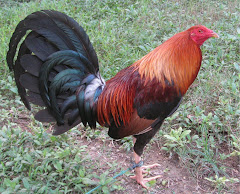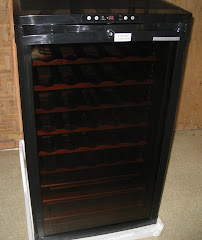Sunday, March 29, 2009
Cannibalism: Prevention and Treatment
By Phillip J. Clauer, Poultry Extension Specialist Animal & Poultry Sciences Department - Cannibalism in fowl is a costly and vicious habit that poultry producers can not afford to ignore. It may occur at any age among all breeds, strains and sexes of fowl.
Cannibalism usually occurs when the birds are stressed by a poor management practice. Once becoming stressed, one bird begins picking the feathers, comb, toes or vent of another bird. Once an open wound or blood is visible on the bird, the vicious habit of cannibalism can spread rapidly through the entire flock. If you notice the problem soon after it begins, cannibalism can be held in check. However, if the problem is allowed to get out of hand it can be very costly. Cannibalism will lower the birds value due to torn and damaged flesh, poor feathering and can result in high death losses. Once this habit gets out of hand it is difficult to eliminate.
Since there are numerous reasons for outbreaks of cannibalism, it is important that cannibalism control be a part of your management program.
I. Cannibalism is usually caused by one or more of these conditions:
1. Overcrowding: chicks should be allowed:
1/4 sq. ft./bird for first 2 weeks
1/2 sq. ft./bird for 3-8 weeks
1 sq. ft./bird from 8 to 16 weeks of age
1.5 sq. ft./bird from 16 weeks on
With gamebirds, double the above recommendations. With pheasants, allow 25 to 30 sq.ft./bird after 12 weeks of age or use pick prevention devices.
2. Excessive heat: When the birds become uncomfortably hot they can become extremely cannibalistic. Be sure to adjust the brooding temperature as the young fowl get older. Brood young fowl at 95°F. for the first week and then decrease the temperature 5°F. per week, until you reach 70°F. or the outside temperature. The temperature should be measured at the height of the birds back directly under the heat source. Do not heat the entire brooding facility to the recommended temperature.
3. Excessive light: Extremely bright light or excessively long periods of light will cause birds to become hostile toward one another. Never use white light bulbs larger than 40 watts to brood fowl. If larger bulbs are required for heat, use red or infra-red bulbs. In birds 12 weeks of age or older, use 15 or 25 watt bulbs above feeding and watering areas. Don't light fowl more than 16 hours per day. Constant light can be stressful to the birds.
4. Absence of feed or water or a shortage of feeder and waterer space: If the birds have to fight for food and water, or if the birds are always hungry they will increase pecking. Be sure that birds have free access to water and feed at all times.
5. Unbalanced diets: Extremely high energy and low fiber diets cause the birds to be extra active and aggressive. Feed lacking protein and other nutrients, particularly Methionine, will also cause birds to pick feathers. Make sure you feed a diet balanced appropriately for the age and types of fowl you are raising.
6. Mixing of different types and colors of fowl: Mixing different ages of fowl or fowl with different traits promotes pecking by disrupting the flocks normal pecking order. Never brood different species of birds together. Don't brood feathered leg fowl, crested fowl or bearded fowl with fowl without these traits. Curiosity can also start pecking.
7. Abrupt changes in environment or management practices: If you plan to move young birds to a new location, it is best to move some of their feeders and waterers with them in order to help them adapt. When you change over to larger feeders and waterers it is helpful to leave the smaller equipment in the pen for a few days to help during the change.
8. Brightly lit nests or shortage of nesting boxes: Don't place bright lights near the nesting areas. Also, allow 1 nest for every 5 hens. Vent pecking by layers is also a common problem.
9. Allowing cripples, injured or dead birds to remain in a flock: Fowl will pick on cripples or dead birds in their pens because of the social order and curiosity. Once pecking starts it can quickly develop into a vicious habit.
10. Slow feathering birds are most prone to cannibalism: Take extra precautions with slow feathering birds. Most cannibalism occurs during father growth in young fowl. Birds with slow feathering have immature tender feathers exposed for longer periods of time leaving them open to damage from pecking. Don't raise slow feathering birds with other fowl.
II. Additional preventive measures include:
1. Allow the birds to use up their energy in an enclosed outside run. This will keep the birds busy and allow them to peck greens, ground and insects instead of other birds.
2. Give the birds a large handful of fresh greens like clover grass or weeds, each day. This increases the fiber in the birds diet. High fiber diets keep the birds crop full and makes the birds more content.
3. Use of mechanical devices in aggressive birds like gamebirds is advisable.
4. Finally, beak trimming is used in most commercial laying flocks. Trim the beak by remove _ of the tope beak and about 1/3 of the lower beak providing a square tip. This makes it difficult for the birds to harm each other. However, beak trimming should b done by someone experienced in proper trimming.
III. Treatment for a cannibalism outbreak:
1. Since cannibalism can be caused by several conditions, you may not be able to determine the exact cause of the problem. However, stress no matter how slight, is usually the main factor.
o Try to correct any practices which may have lead to cannibalism.
o Darkening the facilities by using red bulbs.
o Remove any badly injured birds.
o Applying an "anti-peck" ointment or pine tar on any damaged birds usually stops pecking.
o Lower the pen temperature a bit if possible.
o Don't take chances! Make the cannibalism control part of your management program and you will save a great deal of time and money.
Source: University of Virginia Virginia Cooperative Extension - July 2004
4th MANA monthly Pasabong in Pasay April 15

A tough but friendly competition is once again expected when Masang Nagmamanok (MANA) stages its 4th monthly pasabong at Pasay City Cockpit on April 15. As usual, it is expected to draw participants among MANA members and non-members alike.
All three past MANA pasabong in Pasay have been very successful.
The coming affair is a one-cock fastest kill ulutan. The entry fee is only P1,100 and the minimum bet pegged at P2,200. Guaranteed prize is P100,000 plus a gold “Singsing ng Kagalingan” worth P10,000 to the MANA Fighter of the Month.
More extra prices are expected as sponsors regularly give out incentives and prices during MANA pasabong. For the months of January and February P30 thousand worth of extra prices were awarded during each of the pasabong. In March some P20 thousand extra was given out to the winners and participants.
All participants of MANA pasabong, starting April 15, will receive free one-month-subscription to “Larga.”
Beginning with this issue Larga will carry the column “Llamado Tayo” by Rey Bajenting, the column responsible for organizing MANA, a movement and association of common sabungeros nationwide.
Pasay cockpit holds fastest kill on Wednesdays. MANA’s slot is every 3rd Wednesday of the month. For the past three months the MANA edition averaged more than 60 fights.
MANA is organizing pasabong nationwide as means of attracting awareness and attention to its objectives.
Among its objectives are: to promote the welfare of common sabungeros and to help preserve sabong as a sport, livelihood, industry and cultural heritage. This, in the wake of threats from animal welfare groups to illegalize sabong in the Philippines like what they managed to do in other countries, including the United States.
Proceeds of the pasabong may also be used by MANA for its projects and in furtherance of the objectives.
Llamado Tayo nasa LARGA na!
Kamana Rey Bajenting
Larga na!
Taos-puso pong pagbati at pagpasalamat sa pahayagan Larga sa pagbigay sa atin ng pagkakataon na makapagsulat at makapagpahayag. Sa mga di pa nakakaalam, ang pitak Llamado Tayo ay dating lumalabas sa pahayagang Tumbok. Mula Disyembre 20, 2006 hanggang Dec 31, 2008 arawaraw po ang labas ng pitak na ito. Mula Enero, 2009 nag-linggohan nalang po ang labas ng Tumbok, kaya linggohan nalang rin ang Llamado Tayo hanggang nang tuluyang namaalam ang Tumbok noong Feb. 28, 2009.
Ang pitak na ito ay nagtatalakay sa iba’t-ibang aspeto ng sabong. Mga balita; kaalaman; at plain chicken talk. Kung may mga katanungan kayo i-text nyo lang at sisikapin nating masagot.
Ang Llamado Tayo din ang naging tulay sa pagkatatag ng Masang Nagmananok (MANA).
Ang ipaglaban ang sabong at itaguyod ang kapakanan ng kapwa masang sabungero ang simulain ng Masang Nagmamanok (Mana)
Sa loob ng maikling panahon ang MANA ay nakapagdaos ng mga libreng seminar at trainings; naka-pagtalakayan ng husto hinggil sa wastong pagmamanok; nakapunta at nakapamahagi ng kaalaman sa ilang farm sa iba’t-ibang lugar ng bansa para sa hands-on- at-farm technology transfer. Natugunan ang daan-daang tanong ng mga mambabasa ng Llamado tayo. May blog ang MANA sa internet, ang tilaok.blogspot.com.
Ngayon 2009, may dalawang malalaking proyekto inumpisahan ang MANA. Ang buwanang pasabong sa Pasay City Cockpit at ang Gamefowl Dispersal Program sa Teresa, Rizal. Bawat pangatlong Miyerkules ng buwan ang pasabong ng MANA sa Pasay.
Inasahan na sa tulong ngayon ng Larga, mas lalo pang lalago ang mga serbisyo ng MANA.
Pasay pasabong.
Simula noong Enero may pasabong ang MANA sa Pasay Cockpit bawat pangatlong Miyerkules ng buwan. Tatlong pasabong na ang naganap. Ang pang apat ay sa April 15 na naman. Sa pasabong na ito at sa bawat pasabong ng MANA invited po ang lahat, kamana man (kasapi ng MANA) o hindi. Sana’y mapaunlakan nyo kami. 1-cock ulutan; P1,100 lang ang entry fee at P2,200 ang minimum.
P100 thousand ang guaranteed prize. May gintong Singsing ng Kagalingan pa na maaring mapanalunan ng MANA Fighter of the Month. Ang singsing na ito ay nagkakahalaga ng P10 libo.
Sa kasalukuyan, tatlo ka tao palang ang may suot ng singsing na ito. Mapapanalunan ito ng sinumang may pinakamabilis na combined time ng tatlong sunod-sunod na panalo sa partikular na pasabong. Ang pinakamabilis po sa tatlong MANA Fighters of the Month mula Enero hanggang Marso ay si kamanang Ed Genova, ang nagwagi sa buwan ng Pebrero. Naipanalo niya ang tatlong manok sa loob lang ng 48 seconds . Congrats at salamat kamanang Ed. Naipakita mo ang MANA power, at ang power ng Taguig chapter. Talagang maasahan naman ang Taguig chapter ninyo ni kamanang Mhon Dayao.
MANA-Cavite
Ipinagbibigay alam ng MANA-Cavite na pinaigting nila ang membership drive at activities ng MANA sa area nila. May scheduled seminar sa May at pasabong sa June sa Cavite. Announcement of exact dates and venue to follow according to kamananang Isagani Dominguez. At, tulad ng Comelec continuing registration sila sa gustong mag pamembro ng MANA sa Cavite. I-text nyo lang ang inyong pangalan, address, at kontak number kina:
Kamana Isagani Dominguez, 0928-521-2513; kamana Andoy Malinao, 0919-320-2808; kamana Noel Pili, 0921-764-0768 at kamana Bong Ferreras 0921-332-2231.
Kaalaman: Urban Conditioning
Nakasanayan ng Llamado Tayo na mamahagi ng kaalaman sa pagmamanok, doon pa man sa dating pahayagan. Ganito din ang gagawin natin dito sa Larga. Kung may mga katanungan kayo i-text nyo lang at sisikapin nating masagot.
Sa ngayon tatalakayin muna natin ang tinatawag nating urban conditioning.
Ang urban conditioning ay bagay satin, mga karaniwang sabungero na nasa lungsod. Mga sabungero na malimit sa hack fights lang lumalaban.
Una sa lahat, purgahin ang mga manok at paliguan ng anti-mite shampoo. At saka tingnan kung di ba sobrang mabigat o payat ang mga manok. Kapag ayos lang, samakatuwid ay handa na sila isabak sa ating urban conditioning
Ito’y matipid sa pera, sa panahon, at sa lugar. Kaya natin itong gawin kahit nag-iisa. Ang kakailanganin lang ay ang cord o talian na hindi aabot sa P20 ang halaga; 3x3 folding wire pen na mabibili sa halagang P200; kulungan na siguro'y gagasta ka ng P100 bawat isa; at maliit na sulok sa iyong bakuran na mai-ilawan kung saan pwede pakainin at bahagyang i-exercise ang manok kung gabi. Dahil hindi naman tayo mapera at walang sapat na lugar hindi na tayo gagasta para sa conditioning at running pens, flying pen, pointing pen, scratch box, at ano pa.
Ang pakain naman natin ay karaniwang grain concentrate, maintenance pellets at hi-protein conditioner pellets. Hindi puro hi protein ang ginagamit natin para makamura tayo. Tiyakin lang natin ang pigeon pellets o maintenance pellets ay may mataas na crude protein contents o mataas ang porsyento ng protina 17 o 18%. Kung ang isang kilo nito ay hahaluan natin ng isang kilo ring concentrate magkakaruon na tayo ng pagkain na may 15-16% protein, tulad ng mga pre-mix maintenance feeds na mabibili sa mga agrivet supplies. Kung haluan pa natin ng kunting hi-protein pellets o yong protein expander lalo pang tataas ang crude protein at maging sapat na para panlaban.
Karamihan sa atin ay nasa lungsod o bayan nagmamanok at wala sa malalayong farm sa probinsya, tulad ng malalaking manukan. Ang lupa sa lungsod ay hindi kasingyaman sa minerals. Kaya pinapayo na gamitan natin ng mineral supplement ang ating mga manok. May mga multivitamins with electolites (MVE) o kaya’y concentrated liquid mineral na available sa merkado.
At sa lungsod mas matindi ang air pollution kaya kailangan ng manok ang anti-oxidant tulad ng Vits A, C at E. Makukuha ito sa mga MVE o sa multivitamin tablets. Makakatulong kung haluan natin ng kunting gulay, sibuyas at kamatis ang ating pakain.
Dahil walang tiyak na schedule ang laban ng ating manok, dapat ay ito ay isang boy scout, laging handa. Mas mainam na sa kulungan lang ito patulugin sa gabi upang hindi mabasa kung umulan at mahirap pa nakawin. Ilabas ito kina-umagahan mga bandang alas singko ng umaga at ilagay sa cord. Bandang alas-sais ikahig at isampisampi ito ng dalawa o tatlong minuto. Kung tayo lang mag-isa at wala katulong sa pagkakahig doon na lang ikahig at isampi sa isang manok na nakatali. Yung hindi pa ilalaban o isang reject o baldado na. Pagkatapos ay ilagay mo sa 3x3 na may lamang tuyong dahon ng saging. Bigyan ng iilang pirasong cracked corn at pabayaang mag scratch ng 10 minuto. Pagkatapos ay ibalik ito sa cord.
Pakainin alas-siyete at huwag kalimutang bigyan ng tubig. Pabayaan lang sa talian hanggang tanghali. Kung ikaw ay may pasok siguruhin na palaging may masisilungan ang manok sakaling uminit o umulan. At ihabilin sa iyong asawa o anak o sino man ang maiiwan sa bahay na tingnan na walang aksidenteng mangyayari sa manok.
Mas mainam kung tayo ay makakauwi sa tanghali. Pag-uwi sa tanghali hilamusan agad ang manok at ilagay sa 3x3 na may tuyong dahon ng saging at bigyan ng kaunting pakain at hayaang kumaskas habang tayo ay nananghalian. Pagkatapos ay ibalik sa cord buong maghapon.
Paguwi natin sa hapon pakainin ang manok. Kung ang uwi natin ay palaging maaga at maliwanag pa duon nalang pakainin sa cord. Pagkatapos hayaan sa talian. Pag itoy humapon na ibalik sa lupa at hayaang humapon uli. Ulit-ulitin ng apat o limang beses ang pagbaba sa gayon ay mapilitan itong lumipad at humapon uli pabalik at ma-ehersisyo ng husto. Para na ring nasa flypen ito. Kung medyo madilim na ang dating natin, kailangan natin ang lugar na may ilaw at doon pakainin.
Ganito lang ang gagawin mula Lunes hanggang Biyernes. Tuwing Sabado ipahinga na si manok matapos ang pananghalian. Ilagay sa kulungan buong hapon at ilabas sandali sa oras ng kanyang pagkain sa hapon. Sa Linggo, ilabas ito at ilagay sa cord mga alas-sais ng umaga. Pakainin alas-siyete at paglipas ng 30 minuto ibalik sa kulungan. Handa na si manok kung sakaling ilalaban natin sa araw na ito. Kung hindi mailalaban dahil kulang ang pamusta o kaya natalo tayo sa ibang manok, ibitaw o ispar ito bandang alas-tres o alas-kwatro ng hapon.
(Para sa inyong mga katanungan tungkol sa pagmamanok o kaya’y sa MANA si Rey Bajenting ay pwedeng i-text sa mga numerong ito: 0927-995-4876 o 0908-980-8154)
Emerging voice of masang sabungeros

“The common sabungero, may now yet emerge as an organized sector and contribute a voice to the affairs of the sabong industry. Thanks to all who extended support right at the very beginning, when it was needed most.”—Kamana Rey Bajenting, founder Masang Nagmamanok (MANA)
The growth of cockfighting in the Philippines is evident in the entry of giant companies to the gamefowl products market; the proliferation of publications, tv shows, commercials and advertisements about the game; the enormous increase in the numbers of derbies and hack fights nationwide; and the mushrooming of gamefowl breeders and cockers organizations.
Indeed sabong has come a long way from being a lazy Sunday afternoon pastime to a full-blown industry.
Apparently, the millions of common sabungeros such as Juan who takes care of the chickens of rich sabungeros, Pedro who earns a living in the cockpit, Pablo who has a few gamefowl in his backyard, and Jose who regularly pays his way to derby promotions to enjoy his favorite sport, are the backbone of the industry.
Yes. Because for every bigtime breeder how many farmhands tend to his chickens? For every cockpit operator, how many workers earn a living in his cockpit? For every derby participant how many spectators pay for admission to see the fights? For every big-time cocker how many common sabungeros own just a few chickens in their backyards?
Unfortunately, the workers in the gamefowl industry belong to the non-formal sector, thus, they have no access to mainstream socio-economics structures. They have no protection by the labor code; as such they don’t enjoy insurance, medical, educational and pension plans, nor any kind of security. They can’t even get loan from banks and other lending institutions.
Something has to be done about it.
Now, comes Masang Nagmamanaok (MANA), an organization of ordinary sabungeros, mostly small time cockers, backyard breeders and workers in the gamefowl industry— the common cockfighting aficionados.
The first members of MANA were readers of the column LLamado Tayo by Rey Bajenting in the tabloid Tumbok. Bajenting a veteran gamefowl conditioner, handler and breeder from Cebu and founding director of Central Visayas Breeders Association (CVBA) also writes for a number of sabong magazines, and author of manuals, pamphlets and books about cockfighting..
Sometime in mid 2007, a reader Boying Santiago of Camarines Sur, then the PIO of Bicol Gamefowl Breeders Association (BIGBA) suggested that common sabungeros form a nationwide organization through the column LLamado Tayo, with registration for membership done through text messaging. In 3 months, membership reached 2 thousand. This encouraged the primemovers to undertake direct recruitment through seminars and chapters. Numerous seminars have been conducted in different places and provinces in cooperation with companies engaged in the gamefowl industry. To achieve its goal, MANA needed partners from other sectors of the sabong industry.
The very first seminars of MANA were held in regions 7 and 8, all in coordination with Sagupaan Superfeeds. MANA and Sagupaan had a memorandum of agreement wherein MANA members and its gamefowl dispersal projects in Central and Eastern Visayas enjoyed substantial discounts on prices of Sagupaan feeds and medicine.
It was Dr Marlou Sabit, Sagupaan company veterinarian, who coordinated with MANA. Jorge Sales, Sagupaan national sales manager. extended full support to the project.
While MANA had a potential wide mass base, it lacked the logistic necessary for organizing. Sagupaan provided this and well complemented the efforts of the start up organization
In the process, Sagupaan identified with the cause and projected an image of responsiveness and sense of concern for the common sabungero. Thus, Sagupaan’s contribution to the growth of MANA had been well acknowledged by MANA officers and members.
Sagupaan products, particularly Selectrogen, B50/2 and Complexor 2000 figured prominently in MANA’s manual on conditioning, the “Manwal ng Mana sa Makabagong Pamamaraan ng Pagpili at Pagkundisyon.”. These Sagupaan products are widely used by MANA members nationwide.
Now MANA has more than 11 thousand members. The bulk, about 70%, were garnered through text registration. The 30% of the members registered through seminars and chapters. Certainly thousands more have heard of, MANA and supports its objectives. MANA hopes to reach out further to its wide mass base well distributed to every region, province, city and municipality in the country, in order to attract more members and supporters.
Sabong is a P50 Billion-a-year industry in the Philippines. Some estimates put the number of Filipinos involved in the industry at as many as 10 million. MANA’s conservative estimate puts it at 5% of the male population or, at least, more than 2 million.
Of these, an estimated 100 thousand are directly making a living at cockpits as sentensyador,mananari, taga-ulot, kasador, house kristos, medics, gatekeepers and utility workers. There are about 1,500 licensed cockpits in the Philippines. A much greater number are working at big farms and cocking stables as handlers, feeders, and farmhands. And, there are those who engage in the micro-industry of making and producing cocking equipment and paraphernalia.
These workers do not enjoy protection under the labor code and most do not have pension, medical and insurance coverage. It is about time somebody look after their welfare.
The objectives of MANA are:
1. To uphold the interest and promote the welfare of common sabungeros, especially the workers in the industry such as the handlers, mananari, kristos, and others who make a living from sabong;
2. To fight for the preservation of sabong as sport, livelihood, industry and cultural heritage.
3. To inform and educate the common sabungeros of the advanced technologies in cockfighting.
4. For the members to work together; and for MANA as a whole to work with others for the good of sabong and the welfare of the common sabungero.
MANA continues to impart gamefowl management knowledge and promote awareness through seminars and trainings, hands-on-at-farm technology transfer; information through publications, radio; and the regular monthly pasabong at Pasay Cockpit, held every 3rd Wednesday of the month starting January 2009. More MANA pasabong are exspected. On June 20, 2009 will be MANA’s inaugural pasabong in Cavite Coliseum in Bacoor, Cavite. Another one will start in Las Pinas Coliseum in July 2009. More are expected to start in Bicol, Cebu and other parts of the Visayas before 2009 ends.
MANA is also setting up gamefowl dispersal projects for members in Teresa, Rizal, City of Naga and Ronda, Cebu and in Lawaan, Eastern Samar.
Its books and publications include Tilaok newsletter; Manwal ng Mana sa Makabagong Pamamaraan ng Pagpili at Pagkundisyon; Manwal ng Mana sa Praktikal na Pagpalalahi; Power Pointing; Don’t Leave Luck to Chance: Introduction to modern science of cockfighting; and Gamefowl Dispersal Program’s Nutrition and Supplementation. The column Llamado Tayo is now carried by the sabong newsweekly Larga.
Now, the common sabungero, indeed the real backbone of the gamefowl industry, may yet emerge as an organized sector and a voice that may be able to contribute its share to the affairs of the industry.
Welcome. To read the articles, please click post link or month, then subsequent post link.
Ponkan broodcock

One of the ponkan broodcocks being readied by RB Sugbo for the incoming breeding season. RB Sugbo is among the gamefowl farms very much involved in the Masang Nagmamanok (MANA) Inc. nationwide gamefowl dispersal program.
Another ponkan

Another ponkan broodcock in the trio pen.
Mana: Dami at Pagkakaisa
Walang duda napakalaki na ng pinagunlad ng sabong mula sa paging libangan tuwing araw ng Linggo, ito ngayon ay isa nang napakatanyag na isport, malaking industriya at kaakitakit na mapagkakitaan.
Napakarami nang nagpapalahi ng manok panabong. Nagsilabasan ang mga babasahin at programa sa telebisyon ukol sa sabong.
Sa bawat nagpapalahi, ilan ang tagapagalaga ng kanyang manok? Sa bawat may-ari ng sabungan, ilan ang naghahanapbuhay sa sabungan niya? Sa bawat kasali sa derby, ilan ang nagbabayad sa pinto upang manood? Sa bawat malaking sabungero, ilan ang mayroon lang iilang pirasong tinale sa kanilang bakuran? Dapat lang, at napapanahon na siguro, na ang masang sabungero ay mapagtuonan ng pansin, mabigyan ng kinatawan, at, marinig ang boses sa isport at industriya ng sabong.
Ito ang nais abutin ng MANA (Masang Nagmamanok), isang pambansang kilusan at samahan ng mga masang sabungero. Ang mga layunin ng MANA ay ang sumusunod:
1. Ang pangalagaan ang kapakanan ng mga maliit na sabungero, partikular na, ang mga naghahanapbuhay sa sabungan. Inaasam na sa darating na panahon, ang mga handlers, mananari, casador, kristos, sentensiyador, farm hands ay magkakaroon ng mga benepisyo tulad ng insurance, pension at iba pa.
2. Ang mapatingkad ang kaalaman ng ordinaryong sabungero sa pagmamanok. At, sila’y mabigyan ng pagkakataon na magkaroon ng angkop na materyales sa pagpapalahi at paglalaban.
3. Ang ipaglaban ang sabong sa gitna ng banta na itoy gawing labag sa batas tulad ng nangyari kamakailan lang sa Estados Unidos, at ipreserba ito bilang isport, hanapbuhay, industriya at bahagi ng ating kultura at tunay na mana.
4. Ang magtulungan at makipagtulungan sa iba pang haligi ng industriya sa ikabubuti ng sabong at ikauunlad ng lahat na mga sabungero.
Inaasahan na matupad ng MANA ang nasabing mga layunin pamamagitan ng pagpakita ng dami at pagkakaisa.
Ang pagkatatag ng MANA ay bunsod ng mungkahi ni kamanang Boying
Ang Llamado Tayo ay tumatalakay sa ibatibang aspeto sa pagmamanok at binabasa ng napakarami arawaraw, kaya di nagtagal marami ang sumapi sa MANA.
Kasunod nito, ang MANA ay nakapagpaseminar sa ibatibang lugar at rehiyon ng Pilipinas, sa tulong ng mga kumpaniya tulad ng Excellence Poultry & Livestock Specialist, Bmeg-Derby Ace, Sagupaan, Secret Weapon, at Thunderbird.






